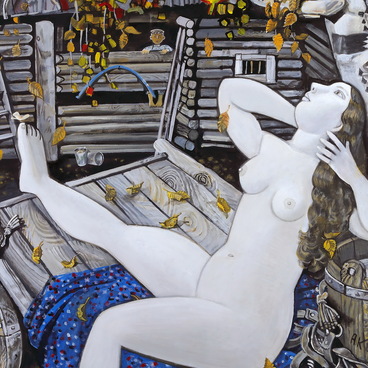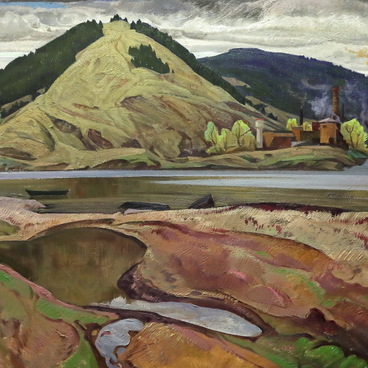Alexander Antonovich Kudrin was an artist, landscape painter, and graphic illustrator. In his painting “Sverdlovsk in the Evening”, he depicted the main street in Sverdlovsk — Lenin Avenue.
The history and appearance of the street are inextricably linked with the history of the city itself. Until 1924, the city of Sverdlovsk had a different name — Yekaterinburg. That year, Yekaterinburg was renamed to honor the revolutionary Yakov Mikhailovich Sverdlov. After the perestroika, the city returned to its historical name of Yekaterinburg, but the region is still known as Sverdlovsk.
Yekaterinburg was founded as a manufacturing center and fortress on the Iset River in 1723. The current Lenin Avenue is the oldest street in the city. It originated on the territory of the plant, and its name was changed several times: it was known as Bolshaya, Pershpektivnaya, Glavnaya Pershpektivnaya, and Prospektivnaya. In 1845, it became Glavny Prospekt. In 1919, the street was renamed Lenin Street, as was the tradition with the central highways in most Soviet cities.
The avenue stretched over old Yekaterinburg from west to east, starting at Verkh-Isetskaya Square and ending at Vtoraya Vostochnaya Street. It crossed the dam of the historic Yekaterinburg plant through the two oldest city squares with two main cathedrals — the Catherine’s Cathedral and the Epiphany Cathedral (both were demolished in 1930).
The main street combined a variety of architectural styles and housed significant buildings of Yekaterinburg. In 1737, the city witnessed the establishment of the first stone classical building — the office of the Main Directorate of Mining Affairs, which is Urals Mussorgsky State Conservatoire nowadays. In the second half of the 19th century, an eclectic building called the Sevastyanov House appeared, nowadays it is the Ural residence of the President of the Russian Federation. In 1912, the Opera and Ballet Theater was built as an example of Art Nouveau.
The 1920s–1930s were marked by extensive construction that unfolded all over the city, including the main street. Numerous pre-revolutionary buildings were demolished and replaced by constructivist buildings: the Press House, the Regional Executive Committee, the Builders Club, and the historical and architectural monument “The Chekists’ Village”. The end of Lenin Avenue was taken by the buildings of the Ural Polytechnic Institute.
Kudrin depicted a crowded, illuminated street of the evening city. The light of lanterns is reflected on the pavement wet from the rain. Passers-by dressed in post-war clothes go about their business. A few cars drive by, and trams rush along their routes.
The history and appearance of the street are inextricably linked with the history of the city itself. Until 1924, the city of Sverdlovsk had a different name — Yekaterinburg. That year, Yekaterinburg was renamed to honor the revolutionary Yakov Mikhailovich Sverdlov. After the perestroika, the city returned to its historical name of Yekaterinburg, but the region is still known as Sverdlovsk.
Yekaterinburg was founded as a manufacturing center and fortress on the Iset River in 1723. The current Lenin Avenue is the oldest street in the city. It originated on the territory of the plant, and its name was changed several times: it was known as Bolshaya, Pershpektivnaya, Glavnaya Pershpektivnaya, and Prospektivnaya. In 1845, it became Glavny Prospekt. In 1919, the street was renamed Lenin Street, as was the tradition with the central highways in most Soviet cities.
The avenue stretched over old Yekaterinburg from west to east, starting at Verkh-Isetskaya Square and ending at Vtoraya Vostochnaya Street. It crossed the dam of the historic Yekaterinburg plant through the two oldest city squares with two main cathedrals — the Catherine’s Cathedral and the Epiphany Cathedral (both were demolished in 1930).
The main street combined a variety of architectural styles and housed significant buildings of Yekaterinburg. In 1737, the city witnessed the establishment of the first stone classical building — the office of the Main Directorate of Mining Affairs, which is Urals Mussorgsky State Conservatoire nowadays. In the second half of the 19th century, an eclectic building called the Sevastyanov House appeared, nowadays it is the Ural residence of the President of the Russian Federation. In 1912, the Opera and Ballet Theater was built as an example of Art Nouveau.
The 1920s–1930s were marked by extensive construction that unfolded all over the city, including the main street. Numerous pre-revolutionary buildings were demolished and replaced by constructivist buildings: the Press House, the Regional Executive Committee, the Builders Club, and the historical and architectural monument “The Chekists’ Village”. The end of Lenin Avenue was taken by the buildings of the Ural Polytechnic Institute.
Kudrin depicted a crowded, illuminated street of the evening city. The light of lanterns is reflected on the pavement wet from the rain. Passers-by dressed in post-war clothes go about their business. A few cars drive by, and trams rush along their routes.

